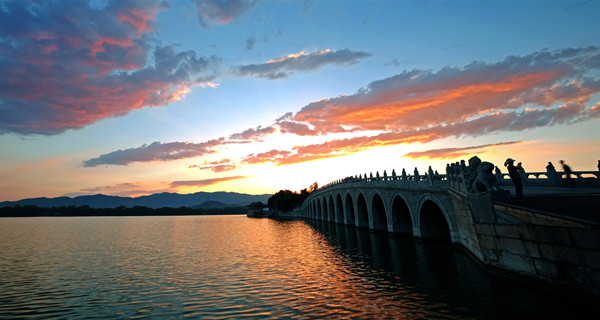
Kunming Lake
It covers about three quarters of the Summer Palace, with an area of 3000 mu (about 2 square kilometers). The Summer Palace is the existing scale and most magnificent of Chinese classical gardens. Together with the Longevity Hill, Kunming Lake forms the key landscape features of the Summer Palace gardens. It is located by the southern side of Longevity Hill, which is a part of Xishan Mountain and has a relative height of 60 meters. This lake is a man-made lake, so it is a little bit shallow, with an average depth of only 1.7 meters.
There are a total of 6 bridges around the lake. They all have different shapes. And the largest bridge here is the 17-arch Bridge, which connects the eastern shore with South Lake Island and is 150 meters long. Near to the bridge, there is a bronze ox sculpture on the eastern shore of this lake. Kunming Lake was designed to represent the traditional Chinese gardening practice of "one pond, three hills", which contains rich Chinese geomantic theory.
Long Corridor
It is located in the south of Longevity Hill, facing Kunming Lake. It is east to on the Yaoyue Door and west to Shizhang Pavilion with 273 intervals. It has a total length of 728 meters, honors to be the longest corridor of the Chinese garden. In 1992, it was recognized as the longest corridor in the world and listed in the "Guinness Book of World Records". It is famous for the beautiful architectures, winding-changing shape and extremely rich and prestigious paintings. Every beam is painting pictures. According to related data, there are a total of more than 14,000 pieces of paintings, including landscapes, flowers, birds, fish and insects, figures allusions etc. portraits on the paintings are drawn from the Chinese classics.
The Tower of Buddhist Incense
It is one of the main buildings of the Summer Palace. It is built on Longevity Hill, on a 21-meters high platform. It faces Kunming Lake in the south and is backed by the Wisdom of Sea. There are various buildings around the tower symmetrically. The Tower of Buddhist Incense is 40 meters high and there are eight huge iron pillars in the tower. The structure of it is quite complex, being a classical architectural masterpiece. Beijing Tower of Buddhist Incense is a magnificent religious buildings, it is the center of the whole Summer Palace building layout. The building style of it imitates the Pagoda built in Hangzhou.
During the reign of Qing Emperor Qianlong (1736-1795), Tower of Buddhist Incense was built. In 1860, the tower was destroyed and then it was reconstructed by Guangxu Emperor. In 1900, it was destroyed seriously again in a war. In 1902, it was reconstructed again by Empress Dowager Cixi.
Seventeen Arches Bridge
It is the biggest bridge in the Summer Palace in Beijing City, also the longest bridge in any Chinese imperial garden. It was named for its seventeen arches. It is 150 meters (164 yards) long and 8 meters (8.75 yards) wide, connecting the Octagonal Tower in the east bank of Kunming Lake and the South Lake Isle in the south. This bridge looks like a rainbow linking the human world with the Penglai Fairyland. It was built in 1750 during the reign of Emperor Qianlong in Qing Dynasty, after the design of Marco Polo Bridge, which is 15 km to the southwest of Beijing.
With the biggest arch in the midst of the bridge flanked by sixteen others, from either side to the central arch, one can get nine arches in different sizes from the middle to each end of the bridge. According to ancient thought, the number, nine, is the supreme number for the emperors, because it symbolizes good fortune and safety; and the meticulous design of the bridge embodies it perfectly. With white marble balustrades, it is carved with 544 stone lions in different postures. In addition, there are also four strange animals carved at both ends of the bridge. Strong and powerful, they are outstanding examples of Qing Dynasty stone carving skills. It is unique scenery but one of the stunning landscapes in the Summer Palace. It is just looks like a rainbow arching over the water.
Source: topchinatravel.com



